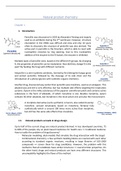Natural product chemistry
Chapter 1
1. Introduction
Penicillin was discovered in 1929 by Alexander Fleming and majorly
used as an antibiotic during the 2nd world-war. However, structure
elucidation in the 1900s was difficult and slow and only 16 years
often its discovery the structure of penicillin was also derived. The
active part in penicillin is the ß-lactam, which is able to react with
nucleophilic enzymes by ring opening. Due to this nucleophilic
addition of the enzyme to the ß-lactam, the enzyme is inhibited.
Multiple types of penicillin exist, based on the different R-groups. By changing
R, the properties of penicillin can be modulated. How did they change R in the
past? By feeding the fungi with different nutrients.
Ampicillin is a semi-synthetic antibiotic, formed by first letting the fungus grow
and extract penicillin, followed by the cleavage of its side chain and the
introduction of a phenyl glycine with synthetic organic chemistry.
Another drug, discovered way earlier than penicillin was morphine, used as an analgesic. This
alkaloid was and still is very effective, but has multiple side effects targeting the respiratory
systems. Opium is the milky substances of the papaver somniferum plant and contains active
substances in the form of alkaloids, of which morphine is one. Besides morphine, opium
contains 36 other alkaloids, but morphine is the most active one and also the most present.
A morphine derivative (semi-synthetic) is heroin, also called di-acetyl-
morphine. Janssen developed, based on morphine, fentanyl fully
synthetically which is around 100 times more active than morphine,
but still has the same side effects than morphine.
1.1. Natural products as leads in drugs design
Up to half of the current drugs are natural product-derived. In less developed countries, 75
to 80% of the people rely on plant-based medicines for health care => traditional medicine.
How to tackle the problem of drug discovery?
- Molecular modeling: dock models that simulate the drug interaction with the target
- Combinatorial chemistry: a few synthetic building blocks are reacted with each other
according to standard organic reactions, resulting in large libraries of 100-1000
compounds => screen them for drug candidates. However, the problem with this
method is that all candidates have similar structures => overall similar properties. On
the other hand, drugs and natural products can have very different structures. This
uncompability highlights the flaws of the method.
1
, 1.2. Modern natural product research
Starting from biological material, such as organisms and plants, an extraction has to be
performed, followed by a fractionation. Upon separation and isolation using HPLC, the
compound can be characterized and its structure can be determined with NMR, MS, IR, XRD
(if crystalline). A pharmacological evaluation is necessary. Finally, analogues can be
synthesized and the mode of action of the compound can be investigated.
Chapter 2
2. Fundamental biosynthetic transformations
2.1. Formation of biosynthetic building blocks
Examples of building blocks for secondary metabolites are:
- acetyl coenzyme A => is the main building block and can be converted to more
complex compounds such as phenols, terpenes, vitamin A (via mevalonic acid),
prostaglandins (via fatty acids)
- shikimic acid => hydroxybenzoic acids, phenols …
- chorismic acid => alkaloids
- phenyl pyruvic acid => phenyl alanine, tyrosine, cinnamic acid, coumarins, flavones,
alkaloids
- amino acids → alkaloids, antibiotics (via NRPS: non ribosomal peptide synthesis)
Overview:
Acetyl coenzyme is a C2 building block (2x C) and can condense to IPP an DMAPP which are
the main building blocks of terpenes.
Secondary metabolites are defines as small organic molecules produced by an organism that
are not essential for their growth, development and reproduction.
2
, 2.2. Origin of structural building blocks
The most common C1 building block is a methyl, provides from
methionine via s-adenosylmethionine (SAM-e) ~ natures Me-I to
methylate.
Acetyl coenzyme can be converted to mevalonic acid
(most common pathway, but others are possible), which
can on its turn be converted to isoprene functionalities
of 5x carbons. Isoprene’s form the basis of all terpenes.
From the aromatic amino acids, aromatic building blocks
can also be derived:
More complex building blocks can be obtained from the
aromatic amino acids without the removal of the amino
group:
From ornithine and lysine, linear amines can be
obtained, which can cyclize to the heterocycle in
a 2nd step.
2.3. Construction of natural products from building blocks
These building blocks can be combined to form more complex compounds. Parthenolide is a
terpene, composed of C5 building blocks (typical for terpenes).
3
, 2.4. Fundamental biosynthetic transformations
2.4.1. Reductions
In bio synthesis, the reducing source is a cofactor: nicotine adenin dinucleotide (phosphate)
=> NADH or NADPH
It is the dihydropyridine nucleotide that is the active agent in this cofactor and causes the
reduction:
The reduction can occur via either the transfer of a hydride, or either the transfer of 2
electrons and a proton, forming the cationic pyridinium salt.
Different enzymes use these cofactors for reducing specific functionalities:
- Alcohol dehydrogenase
- Enoyl reductase
- Imine reduction
The enzyme lowers the activation energy in both directions, so in principle the reaction can
occur in both ways.
Alcohol dehydrogenase
The aldehyde can be reduced to the alcohol or the alcohol can be oxidized to the aldehyde
(what happens in our body when we drink alcohol). In the above scheme one of both
hydrogens has been replaced by a deuterium atom in order to display the stereospecificity of
the reaction. Only the atom in front (here the D) will be transferred to the aldehyde. This
reaction is an enantioselective reaction, typical for enzymatic reactions.
4




